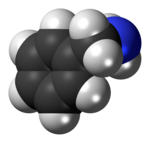Benzylamine
Appearance

| |

| |
| Names | |
|---|---|
| IUPAC name
1-Phenylmethanamine
| |
| Other names
α-Aminotoluene
| |
| Identifiers | |
3D model (JSmol)
|
|
| ChEBI | |
| ChEMBL | |
| ChemSpider | |
| DrugBank | |
| ECHA InfoCard | 100.002.595 |
| KEGG | |
PubChem CID
|
|
| RTECS number |
|
| UNII | |
CompTox Dashboard (EPA)
|
|
| |
| |
| Properties | |
| C7H9N | |
| Molar mass | 107.156 g·mol−1 |
| Appearance | Colorless liquid |
| Odor | weak, ammonia-like |
| Density | 0.981 g/mL[1] |
| Melting point | 10 °C (50 °F; 283 K) |
| Boiling point | 185 °C (365 °F; 458 K) |
| Miscible[2] | |
| Solubility | miscible in ethanol, diethyl ether very soluble in acetone soluble in benzene, chloroform |
| Acidity (pKa) | 9.34[3] |
| Basicity (pKb) | 4.66 |
Refractive index (nD)
|
1.543 |
| Structure | |
| 1.38 D | |
| Hazards | |
| Occupational safety and health (OHS/OSH): | |
Main hazards
|
Flammable |
| NFPA 704 (fire diamond) | |
| Flash point | 65 °C (149 °F; 338 K) |
| Related compounds | |
Except where otherwise noted, data are given for materials in their standard state (at 25 °C [77 °F], 100 kPa).
| |
Benzylamine is the chemical compound with the formula C6H5CH2NH2. It consists of a benzyl group, C6H5CH2, attached to an amine functional group. This colorless liquid is a common precursor in organic synthesis.
Manufacturing
Benzylamine can be produced through a number of ways, the main industrial route being the reaction of benzyl chloride and ammonia. It is also produced by the reduction of benzonitrile and reductive amination of benzaldehyde over Raney nickel.[4]
Uses
It is used as a masked source of ammonia, since after N-alkylation, the benzyl group can be removed by hydrogenolysis:[5]
- C6H5CH2NH2 + 2 RBr → C6H5CH2NR2 + 2 HBr
- C6H5CH2NR2 + H2 → C6H5CH3 + R2NH
Typically a base is employed in the first step to absorb the HBr (or related acid for other kinds of alkylating agents).
References
- ^ a b c d Benzylamine at Sigma-Aldrich
- ^ a b c d Record in the GESTIS Substance Database of the Institute for Occupational Safety and Health
- ^ Hall, H.K. (1957). J. Am. Chem. Soc. 79 (20): 5441. doi:10.1021/ja01577a030.
{{cite journal}}: Missing or empty|title=(help) - ^ Heuer, Lutz (2006). "Benzylamines". Ullmann's Encyclopedia of Industrial Chemistry. doi:10.1002/14356007.a04_009.pub2.
- ^ Gatto, V. J.; Miller, S. R.; Gokel, G. W. (1993). "4,13-Diaza-18-Crown-6". Organic Syntheses
{{cite journal}}: CS1 maint: multiple names: authors list (link); Collected Volumes, vol. 8, p. 152. (example of alklylation of benzylamine followed by hydrogenolysis).


